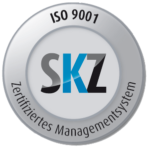The sample is subjected to a controlled temperature program (DIN 51005, ASTM E 473). The most widespread measuring methods are the dynamic differential scanning calorimetry (DSC) and the power-compensating differential scanning calorimetry (pc-DSC). Both methods provide information about both the energy consumed when crystallites melt or of the energy released during crystallization in the cooling phase. Among other applications, this method is used for determining the softening temperature range (or softening range for short) of a polymer, during which many physical properties undergo sudden changes. Within the softening range, for example, polymer material that is hard at room temperature will become viscous. While the hardness and strength of thermoplastics will decrease gradually as they approach the softening range, these properties often deteriorate suddenly within the softening range. The softening temperature may be defined as the temperature at which a given short-term strength starts to weaken or the material starts to deform under its own weight. The torsion pendulum test or characteristic physical values such as thermal conductivity etc. allow an exact determination of the softening temperature. This also allows the measurement of the static or dynamic glass transition temperature, constituting the lower limit of the softening range. This lower limit, i.e. the glass transition temperature, rises in proportion to the degree of polymerization.
Industriestraße 44+48, 47652 Weeze
+49 2837 10510
info@delta-kunststoffe.de

